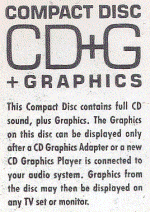Welcome
to the CD+G Section
Since
the Amiga CD32 is one of the few CD players that is
capable of displaying the graphics of the CD+G audio
CDs, I felt it was worthy to put up a separate page
just for the purpose of discussing and answering questions
about the CD+G format.
What
is the CD+G format?
CD+G
discs look like standard audio CD's when played back
on regular CD players or CD-ROM drives. The CD+G format
is an extension of the standard RED-BOOK audio format.
On an audio disc there is an area known as the subchannel.
This
area is used to store data for the cd player like
elapsed time etc. Some of this area is normally unused.
In CD+G discs the subchannel is used to store the
CD+G data. This data consists of commands and graphics
that are interpreted by the player to produce the
CD+G display. (see the pictures of playback on the
left).
How
do I know what CDs are CD+Gs?
Chances
are likely, you would know if you had them, however,
you may not. When you purchased the CD, it probably
had a sticker on it that looked like this:

But,
since you might have bought the CD used - you may
not have the cover plastic anymore. Many CD+Gs have
a new symbol on the CD itself that shows it as a CD+G:

But,
in many cases, even this symbol isn't indicative that
the CD is a CD+G title. Many times, you just might
have to put it into a player to see if graphics appear.
Is
there a list of CD+G music CDs?
Yes,
but it is old and quite incomplete as far as I know.
The CD+G format didn't last long as a popular music
format (it is now replaced by the 'Enhanced CD' format)
but lives on as a Karaoke Music format (at which it
excels). Search the web for "Karaoke CDG"
and you will find MANY places that sell them.
As
for music CDs, you can read
the list here. This list was borrowed and modified
from the now hard to find original CD+G list. If you
know of others, please
let me know so I can update the list.
How
can I play them without a CD32?
There
are dedicated CD+G players, mostly in the form of
stereo equipment or stand-alone Karaoke systems. Some
video game systems (consoles) also play CD+G discs.
These include Commodore CD32 and CDTV, Philips CDI,
NEC TurboDuo, SegaCD, and Sega Saturn.
There
are a couple of utilities for popular computers that
will help you extract and view the CD+G graphics.
I will tell you now that 1) it doesn't work with very
many CD-ROM drives - mostly SCSI, high end drives
can read CD+G code and 2) the programs that are out
there are rather complicated and glitchy to use. But,
if you're ambitious - here is where you can find them
at:
Windows
Users: CDGPLAY
| WinCDG
Macintosh
Users: CDGPLAY

